A Look Back: Star Trek III – The Search for Spock
Every  movie enjoys the same conceit: that the good guys might not win.
movie enjoys the same conceit: that the good guys might not win.
But it’s a fallacy. In most stories, the good guys do wins. There might be twists and all that, but the bulk of stories end with the unspoken fairy tale climax of, And they lived happily ever after.
But for the sake of our enjoyment, we entertain the prospect that they might not.
After all, a predictable plot where we know what’s going to happen isn’t going to compel, excite, and tantalise us. We’ll grow disinterested – just as we would seeing the same repeat for the umpteenth time.
Now the problem arises that some stories are foregone conclusions, and thus can’t sustain that conceit that the good guys might not win.
Take Rocky II (1979), for example. In Rocky (1976), Rocky Balboa (Sylvester Stallone) loses the title fight. Come the rematch in the sequel, well, what’s the chance he’s going to lose again?
Nil. We all know he will win this time around.
Rocky II then keeps us hooked through the journey.
Star Trek III: The Search for Spock (1984) is another such movie.
In Star Trek II: The Wrath of Khan (1982), Spock (Leonard Nimoy) sacrifices his life to save his crew mates. The sequel is named after the search for him, so it’s a pretty good chance they’re going to find him and resurrect him.
Thus, it becomes about the journey.
Plot
Picking up directly after TWOK, Bones (DeForest Kelley) begins experiencing emotional problems. Upon returning to Spacedock, Admiral Morrow (Robert Hooks) informs Admiral James Kirk (William Shatner) that, due to her age, the Enterprise will be decommissioned.
Spock’s father, Sarek (Mark Lenard) comes to Kirk’s home and reveals that although Spock’s physical body died, he would’ve imparted his katra – his living spirit – in Kirk. Kirk says that was impossible as they were physically separated when Spock died. Watching the Enterprise’s records, they see that Spock implanted his katra earlier in Bones.
The USS Grissom is surveying the Genesis planet. Kirk’s son, project leader David Marcus (Merritt Butrick), and science officer Lt. Saavik (Robin Curtis), discover Spock’s tomb – a photon missile tube that was fired into space, and then soft-landed on Genesis. However the tube is empty.
A Klingon commander, Kruge (Christopher Lloyd), learns about Genesis and decides to steal the intelligence. His Bird of Prey attempts to incapacitate the Grissom, but unwittingly destroys it. The Klingons overhear David and Saavik trying to contact the Grissom. They have found a young Spock – Genesis has reconstituted him physically, but he is aging rapidly, as is the planet. David reveals he used “protomatter” in Genesis, as it was the only way to solve certain problems. Saavik reprimands him, saying he’s like his father who breaks the rules when they don’t suit him.
Klingons go down onto the planet and apprehend the trio. Kirk and his crew steal the Enterprise and travel to Genesis. They encounter the Bird of Prey but the battle-torn Enterprise is crippled. Kruge leverages the hostages against Kirk’s compliance, and has his soldiers kill one of them as an example – they are about to kill the young Spock, but David intercedes and is killed instead.
Kirk sets the Enterprise’s self-destruct. The boarding Klingons are destroyed, while Kirk and his crew are beamed down to Genesis. Kruge comes down. Kirk fights him and wins. Kirk has himself and Spock – who’s aged ideally at the exact the age he was when he died – beamed onto the Bird of Prey just as Genesis explodes.
They fly to Vulcan. A ceremony merges Spock’s living spirit with his body.
The story ends with Spock’s crewmates gathering happily around him.
The Premise
I was 12 when I saw The Wrath of Khan, and imagined how Spock could be regenerated. The Genesis device offered the perfect solution. Credit to the filmmakers for foreshadowing that. The problem is that it became a fait accompli.
That would’ve made for a boring story.
But, as with Rocky II, The Search for Spock has enough twists upon the journey to keep the audience engaged. We know they’ll find, rescue, and resurrect Spock. But the story does a great job of surprising us in how they’re going to get there.
Along the way there are a number of brilliant scenes that I consider among the best in (all) Star Trek cinematic history.
Those Scenes
-
- When the Enterprise returns to Spacedock, the crew of the USS Excelsior look at the highlighted battle damage in mixtures of awe and revulsion. The captain of the USS Excelsior, Captain Styles (James Sikking), shakes his head, like he can’t believe it. That Kirk, what a fiend. It’s a little scene, but shows the contrast between a typical Starfleet captain and Kirk.
-
- The theft of the Enterprise is awesome: from when Scott (James Doohan) sabotages the Excelsior to Uhura (Nichelle Nichols) locking up Mr. Adventure (Scott McGinnis), to the Excelsior pursuing the Enterprise out of Spacedock. Great sequence, awesome music, and sweet, sweet visuals.
-
- The brief battle between the Enterprise and the Klingon Bird of Prey creates tension even though each ship only fires one shot apiece. Part of the reason is the stakes; another part is that you’re aware that the Enterprise is vulnerable and that the Bird of Prey has an advantage (its cloaking device). The context adds gravity – much more than if they fired numerous shots at one another.
-
- The self-destruction of the Enterprise is also brilliant – particularly when Kirk and the crew are on Genesis, watching the fiery wreck plummet, and Kirk says, “My God, Bones, what have I done?” And McCoy, answers, “What you had to do, what you always do. Turn death into a fighting chance to live.”
-
- Again, I have to commend Shatner for his acting in the scene when they kill his son. It’s powerful and emotional. Credit also to Shatner for showing that vulnerability.
What Could’ve Been Better
Apparently, the Romulans were going to be the villains, but were then changed to the Klingons. Edward James Olmos was originally going to play Kruge, but then the role went to Christopher Lloyd.
Lloyd’s a good actor and a great comic actor, but is a strange choice to play a fierce Klingon warrior. He does a good job with the material, but doesn’t have that same underlying menace and intensity that Ricardo Montalban has as Khan in The Wrath of Khan.
Also, they could’ve strengthened Kruge’s motivation. He sees Genesis as a possible weapon, but this could’ve been elaborated upon. They could’ve even had him reporting back to the Klingon Empire so there was a greater sense of threat. As it is, he just seems to be operating independently – a villain for the sake of being a villain because the Klingons are antagonists.
Kirstie Alley played Saavik in The Wrath of Khan, but did not return because she was afraid of being typecast. It always hurts a character and continuity when an actor is replaced. Curtis does a good job, but Saavik should be carrying over chemistry from The Wrath of Khan, which doesn’t happen because of the change of actor.
Conclusion
The Search for Spock is the sequel that needed to be made since they had to resurrect Spock so the Enterprise crew could have more adventures, but it does such a good job in keeping the audience engaged, surprising them, and moving them, that the journey to its conclusion remains compelling and entertaining throughout.
And things happen that we genuinely don’t expect: from the murder of David, to the destruction of the Enterprise.
I’ve always felt it’s underrated in the pantheon of Star Trek movies.
